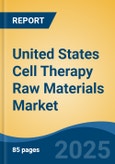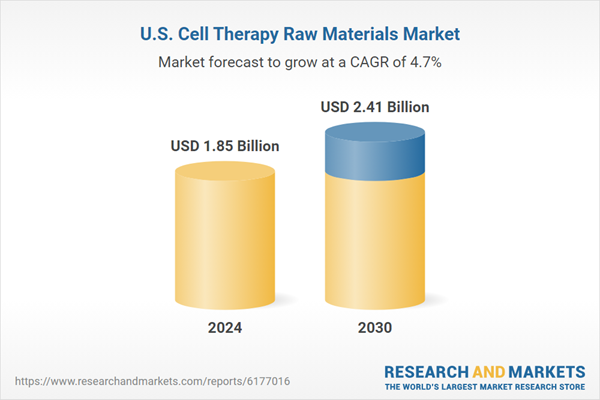Speak directly to the analyst to clarify any post sales queries you may have.
10% Free customizationThis report comes with 10% free customization, enabling you to add data that meets your specific business needs.
Regulatory oversight from agencies such as the FDA reinforces the emphasis on quality, traceability, and safety. Draft guidance published in recent months sets higher expectations for materials derived from human or animal origins, further cementing the need for compliant, transparent supply chains. Nevertheless, the market faces pressures from high costs associated with raw materials and production. These cost burdens can impede broader access to cell therapies, particularly as many treatments remain highly specialized and resource-intensive. Balancing premium quality with affordability will be key in expanding the market’s reach.
Key Market Drivers
Growth in Healthcare Industry
In 2022, the United States allocated approximately 17.8% of its Gross Domestic Product (GDP) to healthcare substantially exceeding the 11.5% average reported by other high-income nations. The expansion of the healthcare industry in the United States is a key driver propelling the growth of the cell therapy raw materials market. As demand for advanced therapeutic solutions continues to rise, particularly in areas such as oncology, regenerative medicine, and rare diseases, there is increasing reliance on high-quality raw materials to support the development and manufacturing of cell-based therapies.Driven by technological advancements and a growing focus on personalized medicine, the healthcare sector is witnessing a surge in clinical trials and commercial approvals of cell therapies. At the IU School of Medicine, researchers in the field of pharmacogenomics are working to deepen the understanding of the relationship between genetics and drug response, with the goal of advancing more personalized and effective medical treatments. In support of this effort, the Indiana Institute for Personalized Medicine, in partnership with the IU School of Medicine’s Department of Medical and Molecular Genetics, has established a CLIA-certified pharmacogenomics laboratory to facilitate high-quality, clinically applicable research. This trend directly contributes to higher demand for raw materials such as growth factors, cytokines, culture media, enzymes, and reagents components that are critical to the viability, consistency, and scalability of cell therapy products.
Key Market Challenges
Limited Supply of Specialized Raw Materials
A critical challenge facing the United States cell therapy raw materials market is the limited supply of highly specialized inputs required for the development and manufacturing of advanced therapies. Cell therapy production depends on a narrow range of raw materials such as GMP-grade cytokines, growth factors, serum-free media, and other biologically sourced components that must meet extremely stringent quality, safety, and regulatory standards. Unlike conventional pharmaceutical ingredients, many of these materials are complex to produce, highly sensitive to storage and handling conditions, and often sourced from a small pool of qualified suppliers.This constrained supply environment can create significant bottlenecks, particularly as demand continues to rise from both clinical research programs and commercial-scale manufacturing efforts. The issue is further exacerbated by long lead times, batch-to-batch variability, and the technical difficulty of scaling production without compromising material integrity. For many manufacturers, the inability to secure a consistent and timely supply of key raw materials poses a serious risk to production continuity and regulatory compliance.
Key Market Trends
Surge in Allogeneic Therapies and Hybrid Formulations
The growing momentum behind allogeneic therapies and hybrid formulations is emerging as a significant trend shaping the United States cell therapy raw materials market. Currently, approximately 195 companies are actively involved in the development of allogeneic cell therapies across a range of therapeutic areas, with oncology representing the primary focus. Within this space, stem cell therapies constitute the largest segment, closely followed by T-cell therapies. North America holds a leading position in the global market, accounting for more than 60% of total market share.Unlike autologous therapies, which use a patient’s own cells, allogeneic cell therapies utilize donor cells, offering the potential for scalable, off-the-shelf treatment options. This shift is driving increased demand for standardized, high-quality raw materials that can support large-scale manufacturing and ensure consistent product quality across batches. As biopharmaceutical companies increasingly focus on allogeneic platforms due to their commercial scalability, there is a rising need for raw materials such as xeno-free culture media, optimized cryopreservation agents, recombinant proteins, and cell expansion reagents.
Key Market Players
- Thermo Fisher Scientific Inc.
- Merck KGaA
- Actylis.
- ACROBiosystems
- STEMCELL Technologies
- Grifols, S.A.
- Charles River Laboratories
- RoosterBio, Inc.
- PromoCell GmbH
- Danaher Corporation
Report Scope
In this report, the United States Cell Therapy Raw Materials Market has been segmented into the following categories, in addition to the industry trends which have also been detailed below:United States Cell Therapy Raw Materials Market, By Product:
- Media
- Sera
- Cell Culture Supplements
- Antibodies
- Reagents & Buffers
- Others
United States Cell Therapy Raw Materials Market, By End Use:
- Biopharmaceutical & Pharmaceutical Companies
- CROs & CMOs
- Others
United States Cell Therapy Raw Materials Market, By Region:
- Northeast
- Midwest
- South
- West
Competitive Landscape
Company Profiles: Detailed analysis of the major companies present in the United States Cell Therapy Raw Materials Market.Available Customizations:
With the given market data, the publisher offers customizations according to a company's specific needs. The following customization options are available for the report.Company Information
- Detailed analysis and profiling of additional market players (up to five).
This product will be delivered within 1-3 business days.
Table of Contents
Companies Mentioned
- Thermo Fisher Scientific Inc.
- Merck KGaA
- Actylis.
- ACROBiosystems
- STEMCELL Technologies
- Grifols, S.A.
- Charles River Laboratories
- RoosterBio, Inc.
- PromoCell GmbH
- Danaher Corporation
Table Information
| Report Attribute | Details |
|---|---|
| No. of Pages | 85 |
| Published | September 2025 |
| Forecast Period | 2024 - 2030 |
| Estimated Market Value ( USD | $ 1.85 Billion |
| Forecasted Market Value ( USD | $ 2.41 Billion |
| Compound Annual Growth Rate | 4.7% |
| Regions Covered | United States |
| No. of Companies Mentioned | 10 |









